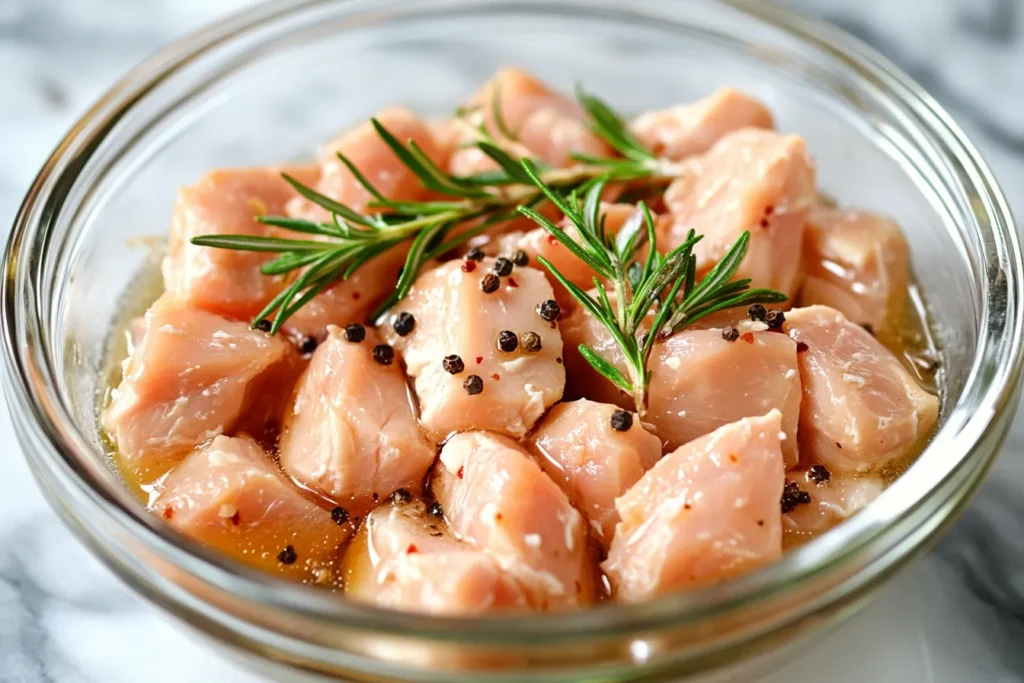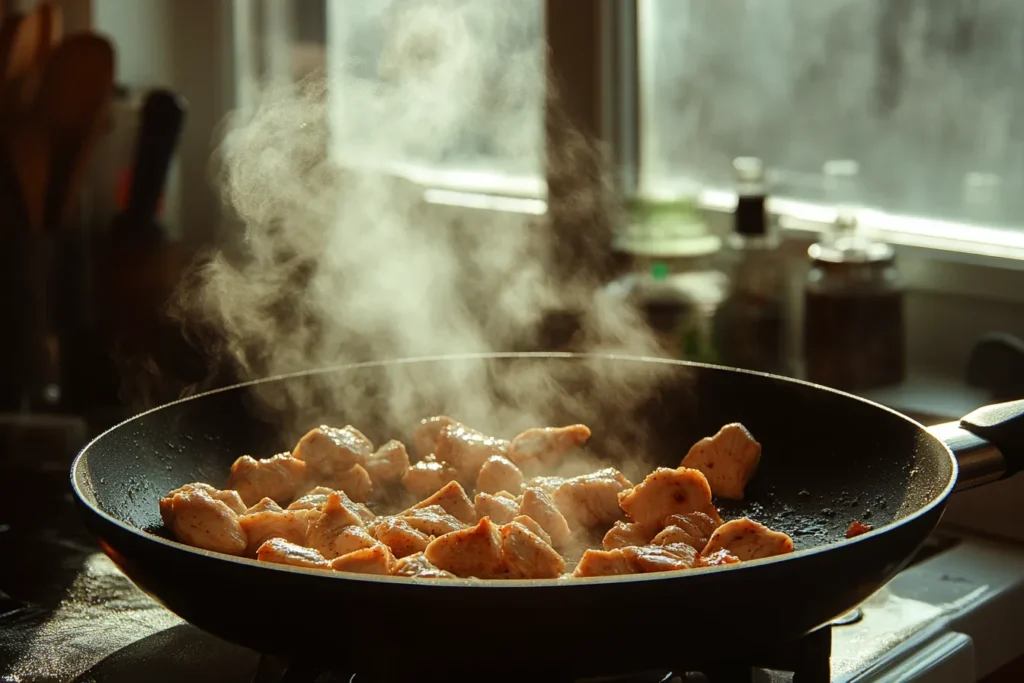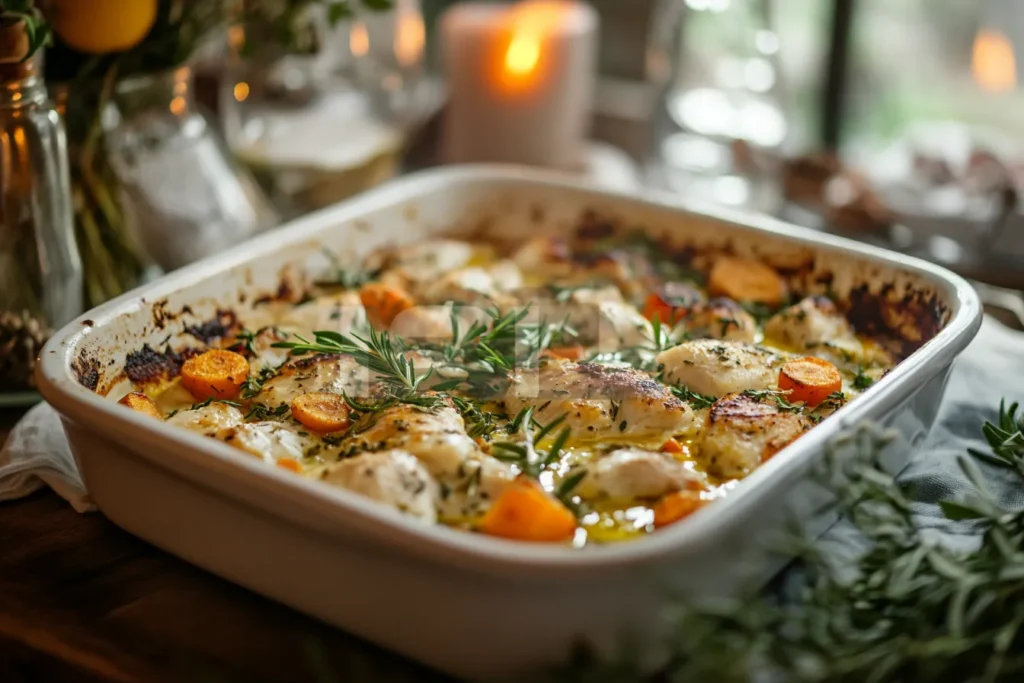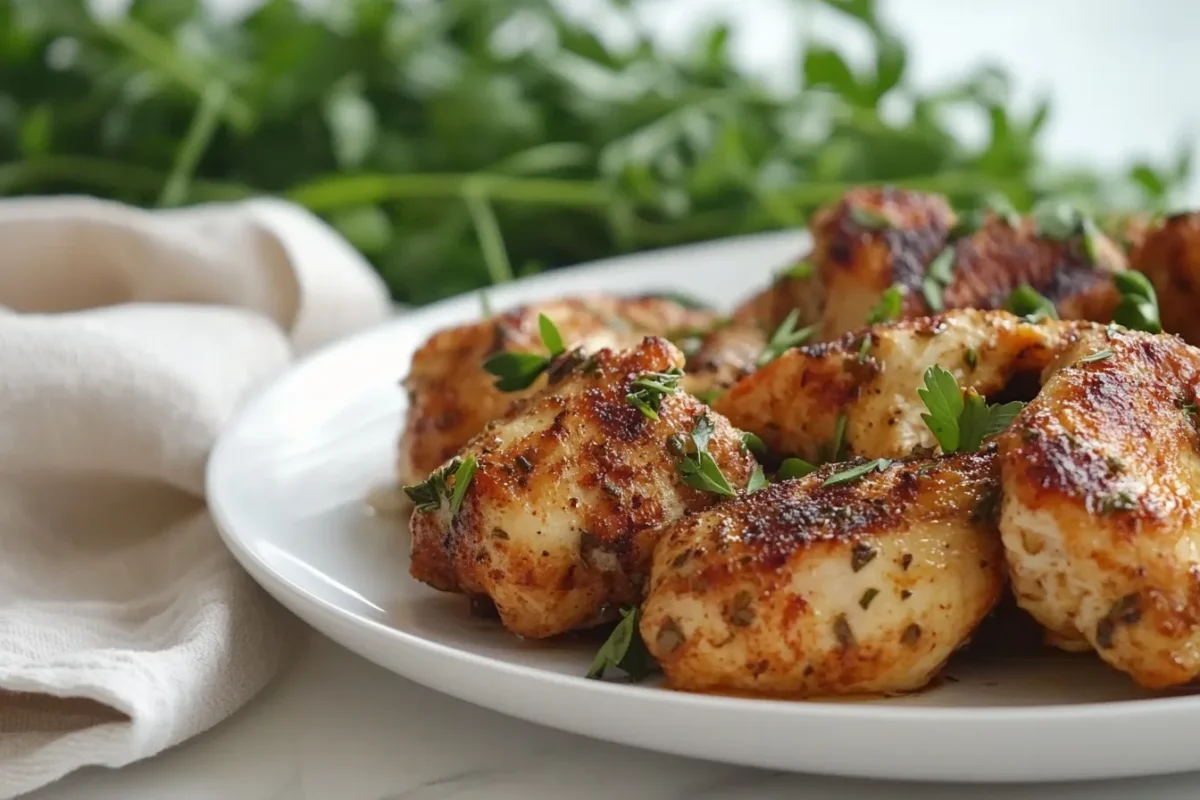Understanding the Importance of Moisture in Diced Chicken
Juiciness isn’t just about taste—it’s about texture and tenderness, too. When you lose moisture in diced chicken, the texture can quickly shift from soft and succulent to tough and dry. Retaining moisture means locking in the natural juices and ensuring every bite feels rich and flavorful. Moisture also helps the seasoning and marinades stick better, making your dishes more flavorful.
Common Challenges in Keeping Diced Chicken Moist
There’s no denying it—cooking diced chicken presents some unique challenges:
- High heat can dry out small pieces: Diced chicken cooks fast but can overcook in seconds.
- Lack of preparation: Skipping crucial steps like marinating or brining means the chicken lacks moisture.
- Wrong cuts of chicken: Certain cuts dry out faster, especially boneless, skinless breast pieces.
- Overcrowding the pan: This creates steam instead of a good sear, preventing crispy edges while causing the chicken to stew in its juices.
By understanding these issues upfront, you’re already ahead of the game. Let’s move on to preparing the chicken properly so that it stays moist during cooking!
Preparation Techniques to Retain Moisture
Selecting the Right Cut of Chicken
Your first step in keeping diced chicken moist is selecting the right type of chicken. Dark meat, like thighs, naturally holds more fat, making it ideal for retaining moisture. That said, boneless chicken breast is still a fantastic option if you pair it with moisture-boosting techniques like marinating and brining.
If possible, opt for fresh chicken over frozen. Once frozen and thawed, the meat can lose some of its natural juices.
Brining: Enhancing Juiciness Before Cooking

Brining involves soaking the chicken in a solution of salt and water (and sometimes sugar and spices) before cooking. This process breaks down proteins and allows the meat to absorb extra liquid.
Key Brining Tips:
- Use 4 cups of water with 1/4 cup salt for a basic brine.
- Let the diced chicken soak for at least 15–30 minutes for small pieces.
- Rinse briefly after brining to remove excess salt but don’t wash away all the goodness!
Brining adds moisture and makes the chicken less prone to overcooking, especially when sautéing or baking.
Marinating: Infusing Flavor and Moisture
Marinating isn’t just for flavor—it’s also one of the easiest ways to retain moisture. A marinade typically consists of three components: fat (like olive oil), acid (like lemon juice or yogurt), and seasonings (spices, herbs, garlic).
Top Tips for Marinating:
- Marinate diced chicken for at least 20 minutes, but avoid exceeding 12 hours to prevent a mushy texture.
- Include yogurt or buttermilk to tenderize the meat while keeping it moist.
- Don’t forget salt—it’s a natural flavor enhancer that also helps the chicken retain water.
Pounding: Ensuring Even Cooking
Have you ever noticed that some diced chicken pieces cook unevenly? That’s because some chunks can be thicker than others. By gently pounding the chicken before dicing, you’re ensuring an even thickness, which helps the meat cook uniformly.
Here’s how:
- Place the chicken breast between two sheets of parchment paper.
- Use a mallet or rolling pin to gently flatten it before dicing.
This step prevents some pieces from drying out while others remain undercooked.
That’s it for the preparation phase! You’re now equipped with the foundational steps to ensure your diced chicken stays tender and full of flavor from the start.
Cooking Methods to Maintain Moisture
Nutritional Facts: Moist and Flavorful Diced Chicken (Per 100g)
| Nutrient | Amount |
|---|---|
| Calories | 165 kcal |
| Protein | 31 g |
| Fat | 3.6 g |
| Saturated Fat | 1 g |
| Carbohydrates | 0 g |
| Sodium | 70 mg |
| Fiber | 0 g |
| Sugar | 0 g |
| Cholesterol | 85 mg |
When it comes to cooking diced chicken, the method you choose can make or break your dish. Cooking it too long or with too much heat can strip away that precious moisture. But fear not! In this section, we’ll cover the best cooking techniques to keep your chicken bites juicy and flavorful.
Sautéing: Quick and Moist Cooking

Sautéing is one of the fastest ways to cook diced chicken while keeping it moist. Because it uses a small amount of oil over medium-high heat, the meat sears quickly and locks in its juices.
Pro Tips for Perfect Sautéed Chicken:
- Use a high-smoke-point oil, like avocado or sunflower oil, to prevent burning.
- Preheat the pan before adding the oil and chicken to achieve that satisfying sizzle.
- Avoid overcrowding the pan—each piece of chicken should have space to brown. Overcrowding causes the chicken to steam instead of sear.
To ensure your chicken doesn’t dry out, sauté for 6–8 minutes total, flipping occasionally until it’s golden brown and cooked through.
Stir-Frying: High Heat, Retained Juices
Similar to sautéing but with constant stirring, stir-frying is a great option for maintaining moisture. The constant movement ensures that no piece stays in contact with the hot surface long enough to overcook.
Key Stir-Frying Tips:
- Use bite-sized pieces that cook quickly.
- Add the chicken to the pan last after stir-frying vegetables, so it doesn’t stay on the heat too long.
- A wok works best for distributing heat evenly, but a deep non-stick pan also works.
Pro Tip: Add a splash of chicken broth or soy sauce during the last minute to infuse extra moisture and keep the dish saucy.
Baking: Oven Techniques for Juicy Diced Chicken

Baking diced chicken in the oven is convenient, but it can easily lead to dry results if done incorrectly. The secret? Covering the chicken and adding moisture.
Top Baking Techniques:
- Preheat the oven to 400°F (200°C) for quick cooking.
- Coat the diced chicken with olive oil, spices, and herbs to seal in the juices.
- Place the chicken in a foil-covered baking dish, or use parchment paper to prevent moisture loss.
Bake for about 15–20 minutes, checking for an internal temperature of 165°F (74°C). For added moisture, consider baking your chicken with veggies or a light broth for a flavorful finish.
Poaching: Gentle Cooking in Liquid
Poaching is an underrated technique for keeping diced chicken moist. By cooking the meat in a simmering liquid, you can retain maximum juiciness and infuse flavors from the liquid itself.
Poaching Steps for Success:
- Fill a pot with enough water or broth to fully submerge the chicken pieces.
- Add aromatics like garlic, bay leaves, and peppercorns for extra flavor.
- Simmer, don’t boil! Keep the heat low so the water gently bubbles.
Poach for about 10–12 minutes until the chicken is cooked through but tender. Poached chicken is perfect for adding to soups, salads, and casseroles.
Grilling: Achieving Moisture with High Heat
Grilling is known for its smoky flavor and charred edges, but it’s also notorious for drying out small cuts of meat. Here’s how to grill diced chicken without losing its moisture:
Grilling Tips for Moist Diced Chicken:
- Marinate your chicken before grilling to create a protective moisture barrier.
- Use skewers to grill small pieces evenly, preventing them from slipping through the grates.
- Grill over medium heat and keep an eye on cooking time—diced pieces only need 6–8 minutes total.
Consider basting the chicken with marinade or olive oil halfway through cooking to keep it moist. A squeeze of lemon at the end adds a bright flavor without drying out the chicken.
With these cooking methods, you can elevate your diced chicken dishes and keep them bursting with flavor and moisture.
Post-Cooking Practices to Keep Diced Chicken Moist
Cooking the chicken correctly is only half the battle—what you do after taking it off the heat plays a huge role in retaining that delicious juiciness. From resting to reheating, small steps can prevent your perfectly cooked chicken from drying out.
Resting the Chicken: Allowing Juices to Redistribute
It’s tempting to dive right in as soon as the chicken is cooked, but giving it time to rest is crucial. Why? Because cutting into it immediately releases the juices that should stay locked inside.
Why Resting Matters:
- Resting allows the juices to redistribute evenly throughout the chicken pieces.
- Skipping this step causes the juices to pool out, leaving dry meat behind.
Resting Tips:
- Let diced chicken rest for 5–10 minutes, covered lightly with foil.
- Avoid tightly sealing with foil, as it can create steam and soften crispy edges.
This simple step helps ensure every bite is packed with moisture rather than feeling dry or stringy.
Incorporating Sauces and Gravies
Adding a flavorful sauce is one of the easiest ways to keep diced chicken moist after cooking. Whether you’re using a tangy marinade, creamy sauce, or rich gravy, these liquids coat the chicken and enhance its juiciness.
Best Practices for Adding Sauces:
- Toss diced chicken in the sauce immediately after cooking so it absorbs the flavors while still warm.
- For stir-fries, deglaze the pan with broth, soy sauce, or a splash of lemon juice to create a quick sauce.
- Avoid heavy sauces that overpower the natural taste—simple ingredients like garlic butter or a light tomato sauce can do wonders.
Even if the chicken dries slightly during cooking, adding a flavorful sauce can save the day and keep every bite tender and delicious.
Proper Storage to Prevent Drying Out
How you store leftover diced chicken can determine whether it stays moist or becomes tough and rubbery. Incorrect storage can sap moisture, even from perfectly cooked pieces.
Key Storage Tips:
- Allow the chicken to cool before sealing it in an airtight container—this prevents condensation, which can make the chicken soggy.
- Add a small amount of broth or sauce to the container before refrigerating to keep moisture levels high.
- Refrigerate for no more than 3–4 days to ensure the best texture and flavor.
If freezing, wrap the diced chicken in plastic wrap or place it in freezer-safe bags to prevent freezer burn.
Reheating Techniques to Maintain Moisture
Reheating diced chicken often results in dry, chewy bites—but it doesn’t have to! The right reheating method can restore moisture and keep your leftovers tasting fresh.
Best Reheating Methods:
- Microwave: Add a few tablespoons of broth or water to the chicken and cover it with a damp paper towel to trap steam. Reheat in 30-second bursts to avoid overcooking.
- Stovetop: Warm the chicken in a non-stick pan over low heat with a splash of broth or oil to prevent drying out. Stir frequently for even heating.
- Oven: Cover the chicken with foil and bake at 300°F (150°C) for 10–12 minutes, adding a bit of liquid to keep it moist.
Avoid reheating chicken multiple times, as this can toughen the texture. By following these reheating tips, your diced chicken will stay juicy and flavorful, even the next day!
By mastering these post-cooking practices, you’ll be able to preserve the moisture in your diced chicken from the stovetop to the plate—and even to leftovers. Up next: Let’s wrap it up with answers to common questions about cooking diced chicken!
Frequently Asked Questions About Keeping Diced Chicken Moist When Cooking
How long should I marinate diced chicken?
Marinating diced chicken for at least 20–30 minutes is recommended to enhance flavor and moisture. If you have time, let it sit for up to 4 hours in the fridge for maximum absorption. However, avoid marinating for more than 12 hours, as the acids can break down the proteins too much, making the texture mushy instead of tender.
What is the ideal internal temperature for cooked diced chicken?
The ideal internal temperature for diced chicken is 165°F (74°C). Use a meat thermometer to check the thickest pieces to ensure they’re fully cooked but not overdone. Cooking chicken past this point can result in dry, chewy meat.
Can I brine chicken for too long?
Yes, over-brining can make chicken overly salty and affect the texture. Small diced pieces should only be brined for 15–30 minutes. If brined longer, they may become too soft or rubbery. Always rinse briefly after brining to remove excess salt.
What oils are best for sautéing diced chicken?
For sautéing diced chicken, use oils with a high smoke point, such as avocado oil, sunflower oil, or canola oil. Olive oil also works well but should be used over medium heat to avoid burning. These oils create a light crust on the outside while keeping the inside moist.
How can I tell if my diced chicken is overcooked?
Overcooked chicken usually appears dry and stringy and may feel rubbery to the touch. If you see a lot of juice escaping when cutting into the pieces, it’s a sign that they’re losing too much moisture. To avoid overcooking, check the doneness early, and remember that chicken continues to cook slightly after being removed from the heat.
Is it better to cook diced chicken with or without the skin?
If you want to maximize moisture, cooking with the skin on can help retain juices, as the fat from the skin creates a natural barrier against drying out. However, for diced chicken, the skin is often removed for convenience. In this case, compensate by using a marinade or brine to lock in moisture.
Conclusion
Cooking moist diced chicken doesn’t have to be complicated. By following key preparation methods like brining, marinating, and pounding, and using cooking techniques such as sautéing, poaching, and stir-frying, you can create juicy and flavorful chicken every time. Don’t forget the importance of resting, proper storage, and reheating methods to maintain tenderness even after cooking.
With these tips in your cooking toolkit, you’ll never have to deal with dry chicken again. Happy cooking, and may every bite be deliciously moist!
For more inspiration and creative ideas, don’t miss our latest article:”chicken and shrimp dishes“. It’s packed with fresh recipes and tips to make your cooking experience even more enjoyable!”
For more inspiration and creative ideas, don’t miss our latest article:”prevent food from drying out“. It’s packed with fresh recipes and tips to make your cooking experience even more enjoyable!”
For more inspiration and creative ideas, don’t miss our latest article:”grilled chicken recipes“. It’s packed with fresh recipes and tips to make your cooking experience even more enjoyable!”

